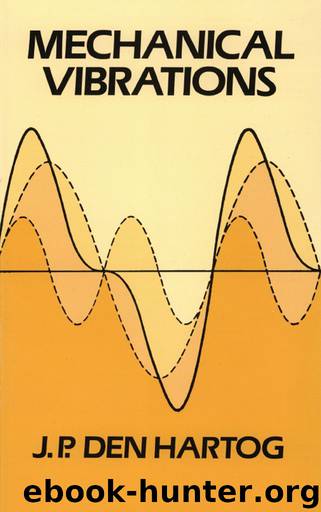Mechanical Vibrations (Dover Civil and Mechanical Engineering) by J. P. Den Hartog

Author:J. P. Den Hartog [Hartog, J. P. Den]
Language: eng
Format: azw3
Publisher: Dover Publications
Published: 2013-02-28T05:00:00+00:00
FIG.6.3. The relative location of S, G, and B for various speeds.
and solving for the shaft deflection r,
This formula coincides with Eq. (2.26) on page 45 for the case of a simple k-m system excited by a force proportional to the square of the frequency. Hence Eq. (6.2) may be represented also by the diagram of Fig. 2.20, which is shown again in Fig.6.3. Taking the points S and G at the fixed distance e apart, the location of B with respect to these two points at each frequency is the projection of the ordinate of the curve on the vertical axis. It is seen immediately that for very slow rotations (ω ≈ 0) the radius of whirl BS is practically zero; at the critical speed, r = BS becomes infinite, while for very large frequencies B coincides with G. Thus at very high speeds the center of gravity remains at rest, which can be easily understood physically, since, if it were not so, the inertia force would become very (infinitely) great.
Equation (6.1) shows that for a perfectly balanced shaft (e = 0), the spring force kr and the centrifugal force mω2r are in equilibrium. Since both are proportional to the deflection, the shaft is in a state of indifferent equilibrium at resonance. It can rotate permanently with any arbitrary amount of bend in it. Whereas below the critical speed the shaft offered some elastic resistance to a sidewise force, this is no longer true at the critical speed. The smallest possible sidewise force causes the deflection to increase indefinitely.
Another interesting conclusion that can be drawn from Fig.6.3 is that, for speeds below the critical, G lies farther away from the center B than S does, whereas, for speeds above the critical, S lies farther outside. The points S and G are on the same side of B at all speeds. Thus below the critical speed the “heavy side flies out,″ whereas above the critical speed the “light side flies out.″
The inertia force or centrifugal force is proportional to the eccentricity of G, which is r + e; and the elastic force is proportional to the eccentricity of S, which is r. The proportionality constants are mω2 and k, respectively. For speeds below the critical, mω2 is smaller than k, so that r + e must be larger than r since the two forces are in equilibrium. At the critical speed, r + e is equal to r, which necessitates that r be infinitely large. Above the critical speed, r + e is smaller than r, which makes r negative.
It is difficult to understand why the shaft, when it is accelerated gradually, should suddenly reverse the relative positions of the three points B, S, and G at the critical speed. In fact the above analysis states merely that at a given constant speed the configuration of the three points, as determined by Fig.6.3, is the only one at which equilibrium exists between the two forces. Whether that equilibrium is stable or unstable, we do not know as yet.
Download
This site does not store any files on its server. We only index and link to content provided by other sites. Please contact the content providers to delete copyright contents if any and email us, we'll remove relevant links or contents immediately.
| Automotive | Engineering |
| Transportation |
Whiskies Galore by Ian Buxton(41524)
Introduction to Aircraft Design (Cambridge Aerospace Series) by John P. Fielding(32884)
Small Unmanned Fixed-wing Aircraft Design by Andrew J. Keane Andras Sobester James P. Scanlan & András Sóbester & James P. Scanlan(32569)
Craft Beer for the Homebrewer by Michael Agnew(17927)
Turbulence by E. J. Noyes(7693)
The Complete Stick Figure Physics Tutorials by Allen Sarah(7135)
Kaplan MCAT General Chemistry Review by Kaplan(6590)
The Thirst by Nesbo Jo(6432)
Bad Blood by John Carreyrou(6271)
Modelling of Convective Heat and Mass Transfer in Rotating Flows by Igor V. Shevchuk(6219)
Learning SQL by Alan Beaulieu(6029)
Weapons of Math Destruction by Cathy O'Neil(5823)
Man-made Catastrophes and Risk Information Concealment by Dmitry Chernov & Didier Sornette(5641)
Digital Minimalism by Cal Newport;(5388)
Life 3.0: Being Human in the Age of Artificial Intelligence by Tegmark Max(5182)
iGen by Jean M. Twenge(5157)
Secrets of Antigravity Propulsion: Tesla, UFOs, and Classified Aerospace Technology by Ph.D. Paul A. Laviolette(4974)
Design of Trajectory Optimization Approach for Space Maneuver Vehicle Skip Entry Problems by Runqi Chai & Al Savvaris & Antonios Tsourdos & Senchun Chai(4837)
Electronic Devices & Circuits by Jacob Millman & Christos C. Halkias(4741)
